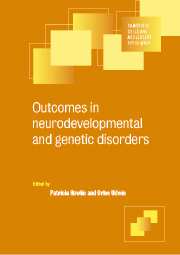Book contents
- Frontmatter
- Contents
- List of contributors
- Preface
- 1 Attention deficit hyperactivity disorder
- 2 Developmental language disorders
- 3 Reading and other specific learning difficulties
- 4 Metabolic disorders
- 5 Hemiplegic cerebral palsy
- 6 Autistic disorders
- 7 Down syndrome
- 8 Fragile X syndrome
- 9 Prader-Willi and Angelman syndromes: from childhood to adult life
- 10 Rett disorder
- 11 Tuberous sclerosis
- 12 Williams and Smith-Magenis syndromes
- Index
11 - Tuberous sclerosis
Published online by Cambridge University Press: 13 August 2009
- Frontmatter
- Contents
- List of contributors
- Preface
- 1 Attention deficit hyperactivity disorder
- 2 Developmental language disorders
- 3 Reading and other specific learning difficulties
- 4 Metabolic disorders
- 5 Hemiplegic cerebral palsy
- 6 Autistic disorders
- 7 Down syndrome
- 8 Fragile X syndrome
- 9 Prader-Willi and Angelman syndromes: from childhood to adult life
- 10 Rett disorder
- 11 Tuberous sclerosis
- 12 Williams and Smith-Magenis syndromes
- Index
Summary
Introduction
Tuberous sclerosis is a complex genetic disorder, characterized by benign growths in many organs including the heart, kidney, skin and brain. It has a prevalence rate of around 1 : 10 000 (O'Callaghan, 1999). Brain abnormalities include cortical tubers (CT), subependymal nodules (SEN) and subependymal giant cell astrocytomas (SEGA). The two genes (TSC1 and TSC2) that cause tuberous sclerosis have been identified in recent years. The TSC1 gene is located on the long arm of chromosome 9 and the TSC2 gene on the short arm of chromosome 16 (The European Chromosome 16 Tuberous Sclerosis Consortium, 1993; van Slegtenhorst et al., 1997). About one-third of cases are familial and inherited in autosomal dominant fashion. The remaining twothirds of cases are due to spontaneous mutations (Povey et al., 1994).
In addition to the spectrum of physical manifestations, tuberous sclerosis is associated with a wide range of behavioural, psychological and neuropsychiatric problems including epilepsy, learning disabilities, autism and multiple disruptive behaviours.
In a review of the genetics of learning disabilities, Simonoff and colleagues highlighted the need to expand knowledge of the effects of genetic abnormalities on the nervous system and on the biological mechanisms of learning disabilities (Simonoff, Bolton & Rutter, 1996). They emphasized the importance of considering not only the direct effects of genetic abnormalities on brain and behaviour, but also the indirect effects that stem from gene-environment correlations and interactions. This conceptual framework can be usefully applied to tuberous sclerosis when considering the ways in which associations with psychopathology arise.
Keywords
- Type
- Chapter
- Information
- Outcomes in Neurodevelopmental and Genetic Disorders , pp. 272 - 298Publisher: Cambridge University PressPrint publication year: 2002
- 7
- Cited by

